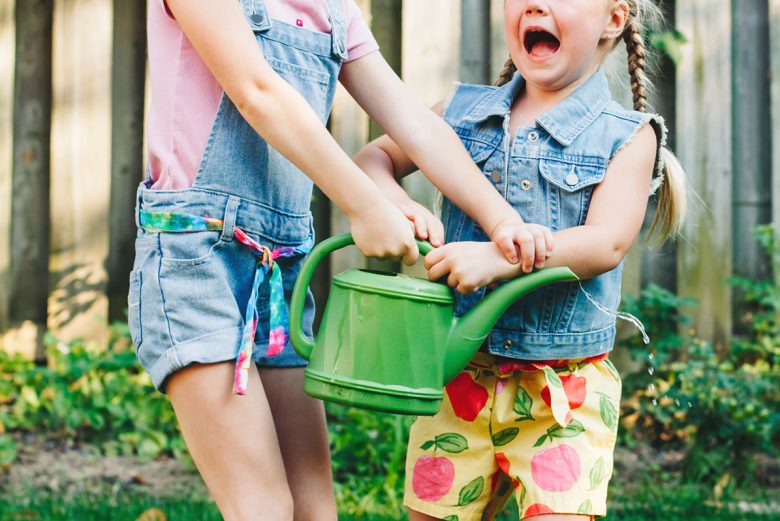
Do your children’s squabbles ever wear you out?
It’s exhausting sometimes. Your children love each other—but too often, they’re at each other’s throats. Ever wish they’d just get along?
In this episode, Carol and Anne share tips and questions to help you create more calm in your home. Listen in for examples of how to help your children not just get along, but also honor and appreciate each other.
This episode’s Parenting Practice
The next time conflict breaks out between your children, rather than being in referee mode, put yourself in coach mode. How can you help them through the communication and sharing their feelings, speaking what they need, and also learning that respect and love for their siblings? Listen to this episode for tips on how to do that.
Transcript of podcast episode
Carol: Welcome to the Child Whisperer podcast. I’m your host, Carol Tuttle, author of the best-selling parenting book, The Child Whisperer. I’m with my co-host, Anne Tuttle Brown.
Anne: We’ve got a great question we’re answering on today’s podcast. This mom asks, “I’m wondering if anyone could share some tips on helping siblings coexist. Type 1 daughter who is 6 and Type 4 son who is 4 tend to really press each other’s buttons and they both have really big reactions. Meanwhile, hubby is working long hours and I’m just trying to keep the house clean, children and animals fed, and everyone alive and happy. I’m a Type 1, so it’s really emotionally and mentally draining for me to be constantly refereeing these two. Can’t we all just get along?”
Carol: That’s very Type 1. Like, well, first of all, it’s pointing out this is a Type 1 parent who you’re like, “Can you just be happy?” You know, yes.
Anne: Just be nice to each other. Just play.
Carol: Just be nice to each other.
Anne: It’s not a big a deal.
Carol: And she’s probably using some of that feedback, you know, rather than addressing what’s set them up for this. They’re too young to reason, “Just be happy. You know, just get along.” It’s like you’ve got to get…
Anne: So we’ve got a six-year-old and a four-year-old Type 1 and Type 4.
Carol: Right, and these patterns can be set up to last for years that they’re at each other. That’s the thing. You want to get to the root of it. Resolve what is setting them up to be at each other because this can go on. Then the story will be, “Yeah, you always were at each other when you were kids.” It becomes like a theme, a pattern that plays out for a long time because it’s an exchange of energy that they’re kind of doing this dance together, Anne. And they trigger each other.
Anne: That’s just the way it is and that’s how it always will be.
Carol: And these triggers are not, you know… They become sort of the… Your biochemistry gets trained to then get triggered again if it’s not a resolution. So just seeing the bigger picture, just telling children to just get along is not going to resolve it. If we can see our children as wanting harmony, they want to get along, they want to have pleasant experiences, they’re wanting to have positive interactions rather than they… I think children can get labeled as being the difficult one or they like to stir it up. And, you know, they like pushing their siblings’ buttons and then they really can…
Anne: Or the one who always cries and tattles.
Carol: Yeah, there is usually one that’s like…
Anne: Instigator?
Carol: …provoking the other one and the other one then reacts in a negative way and they get going, okay? So now we’re putting a label on them to say, “Well, that’s just what they do.” And that’s going to be, again, setting them into motion to have this play out for a much longer time. And so change any labels you might have of they’re the difficult child, they like to get everybody going. They’re stirring it up, too. What if I saw them as wanting harmony? What if this stresses them out, too? What if they didn’t want to do this? What if they wanted to get along with that sibling? You know, they’d actually like to be friends.
Anne: Your language will probably change if you believe that.
Carol: Yeah, you’ve first got to change what you’re projecting on your child and how you’re viewing them so that you see some hope. And you actually project more goodwill towards them because your energy is being… Children feel their parents’ mood, their energy, their presence. They can read you very, very well. And I mean, you know that from your experience as a child. You could tell the mood I was in or kind of my attitude towards something. So you want to have a more positive attitude towards the kids that can easily be labeled as the difficult ones.
Anne: Another tip we would share is using their gifts to help each other, but even before that, help your children learn about each other’s Types and gifts. And so have you read The Child Whisperer as a family or is there one child that’s getting the brunt or feeling misunderstood? Maybe helping explain their tendencies and their gifts to the other siblings so that they can see and appreciate him, that sibling for who they are.
Also something that I will do is praise my children in front of their siblings. Like Sam recently, he’s my Type 2, he’s a 4-year-old, came up, he couldn’t find something, and I said, “Oh, your sister, Katie, she’s so good at finding things. I know she can help you.” And he turned to her with a big smile, “Katie, will you help me find this?” So you’re putting them on the same team rather than, you know, they’re all like trying to fight for mom’s time and it’s a competition. You’re helping them create just that camaraderie and that, “They look out for me. They love me. They’re someone that I can go to.” I love this story from a parent on The Chid Whisperer Facebook group. She says, “My kids are younger but my daughter is Type 1, 4-year-old, and my son, 19 months, is a Type 3. One thing that helps them get along is if I put my Type 1 in charge of helping the Type 3 have fun. She likes to come up with games and things that he can play with and then she feels like she’s taking care of him.” So again, they’re using their gifts to really help and support each other.
Carol: And maybe your children are spending too much time together, or they’re not… The activity they’re involved in isn’t conducive to both of their Types. And they just don’t play well together in that particular setting. So do they need a little more time? Are they sharing a room and they’re just on top of each other? You know, they need space from one another. What kind of break do they need from one another? Maybe it’s as simple, when they’re going at it is to just say, “Okay, break time. You just need to be apart. You need to get out of each other’s energy. You need to be independent from each other.” And if they’re in an activity where it just sets them up to quarrel, then maybe the activity needs to be changed because it’s not conducive to supporting them in a cooperative… What can they do together that endears them to each other in a cooperative manner? So they start to feel what that’s like. You know, and have them come up with some of those suggestions.
Anne: Even separating in spaces. Recently at family dinner, Katie and Roy, both Type 3s. Roy’s two, Katie is eight, were sitting by each other and Katie kept reaching over and touching him because he’s just the cutest little guy and she loves him so much.
Carol: She loves rubbing their heads.
Anne: And she just wants to, yeah, like pull his little hair and touch him and maybe like…
Carol: And he’s old enough now to go.
Anne: Yeah. And to tease him, you know, it’s the little reactions are just adorable. So I mean, it’s cute but it’s bothersome and then it’s a distraction for everybody. And so I said, “Katie, you’re sitting over here.” And she understood, she wouldn’t… I actually thought she’d be like, “Mom, no, okay, I promise I won’t to do it.” But she was like, “Okay,” I think she knew it was a distraction.
Carol: Yeah.
Anne: And it’s been so much better. Okay.
Carol: Well, they can’t touch each other. Roy is old enough and he’s quite clear on what he does not like. And he’s just like, “Knock it off. Like, what are you doing?”
Anne: Yeah. Another tip is to put it in their hands. They need to learn how to work it out.
Carol: That’s right. That’s when I would send you guys. Like, “Okay, go work this out.”
Anne: Yeah, we’ve got a bench in our kitchen area and I put the two kids who were quarreling on the bench and I say, “You need to say what happened, what you did wrong.” So you’re like, you know, you’re admitting what you did.
Carol: This is great for developing communication skills as well.
Anne: Yeah, you’re not just saying, “Well, he pushed me,” you’re saying, “Well, what happened? What did you do?” “Oh, I provoked him.” You know?
Carol: Yeah, they each take…
Anne: And then you just kind of… the order of things. You say what you did wrong, you say how you can be better. And then they say…
Carol: Can Sam do that now? He’s…
Anne: Oh, and Roy can too.
Carol: Roy can too, oh.
Anne: I said, “Roy, what did you do? What did you do?” “I pushed him. I’m sorry.” Actually, the other day, and this now we’re speaking toddlers, which I feel like a lot of the toy…
Carol: Where this develops.
Anne: …struggle comes from, that’s where it develops, you’re right, is Roy took Sam’s toys and threw them across the room and just was like, “I’m not picking them up.” And I said, “Roy, what are you doing?” And he wouldn’t share. Sam was just whining. And I said,” Sam, you need to tell Roy what you want.” Obviously, I could’ve said the whole thing, “Roy, go get his toys. That wasn’t nice.” But I made Sam express, use his words. And this is what you want to use, the NEH, even into teenage say, “Tell him what you need. Tell him what happened.” And he said, “You took my toy and I didn’t like it. Can you go get it for me?” “Okay.” And then he went and he shared it with him. It was just like when it comes from them, it’s so much more powerful of like, “Oh, I hurt my friend’s feelings. I want to help out, I want to do better.” So I mean, I’m always amazed just at how much these little ones can really express and understand rather than mom stepping in and being the one to communicate for them. It’s been such a powerful tool.
Carol: To get yourself out of the referee role.
Anne: Use your words. He doesn’t know how you feel. Tell him what you need.
Carol: Are you refereeing this without empowering them to work it out and come up with cooperative solutions?
Anne: And it’s going to take coaching because to be like, “Just work it out,” that’s not going to go very far. You need to sit down and say, “Tell them how you feel.”
Carol: You’ve got to teach them some skills of listening skills where, okay, let’s listen to them. That accountability of owning their own stuff.
And then the last tip we have is part of it may be are they not feeling enough nurturing and support from you, true to their Type? So they’re acting out with each other because you’ve been just managing… There’s a podcast I really like, Are You Raising a Family or Managing a Household? And it’s about my difference of are you really attuned to each of your children in small, doesn’t-take-a-lot-of-time ways, really supporting them true to their type, or are you just trying to manage the whole household and no one’s really getting their needs met? Children fight more when that’s the case. They just aren’t emotionally supported in their family system. They don’t get along.
Anne: This same mom who asked the question, I followed up with her to let her know we’re answering her question. She said, “I have since figured out that my son is actually a Type 3 and not a Type 4.” Like she’s not… And she said, “And the conflict has decreased because I am parenting him better now as a Type 3. And things are much more peaceful these days because we’ve added a lot more outside physical activity for him.” So I would look, is there… One of those children that keeps getting picked on or is the instigator, what is lacking from what they need and on an individual base?
Carol: Right, and that comes from that parent being aware of them and supporting them and making sure that need is met.
Anne: We’ll end with a great success story. This is from another mom from The Child Whisperer Facebook group. She said, “My Type 4 daughter and Type 3 son are 18 months apart. When they were young, they had many power struggles. We kept on modeling prosocial communication and talking about the importance of loving relationships. Sometimes we just had to get them playing with separate friends. The separation was good too. They are the best of friends and are helping each other through teenage-hood now.”
So it pays off, you know. When you just got to… There are a lot of times… Your parenting practice is rather than being in referee mode, put yourself in coach mode, in helping your children through these conflicts. How can you help them through the communication and sharing their feelings, speaking of what they need, and also learning that respect and love for their siblings?
Thanks for listening. For more support, go to thechildwhisperer.com where you can purchase the book, subscribe to our weekly parenting practice email, and find a transcription and audio of the Child Whisperer podcast. If you’re listening on iTunes, thank you for leaving a review. If you have a parenting question, please send it to [email protected].



